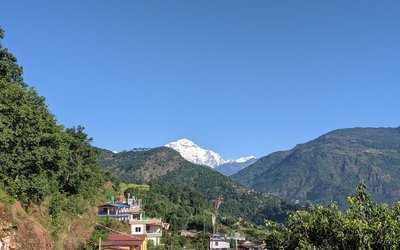
What is the purpose of your visit to Nepal?
We are from the Architecture Department of Regensburg University of Germany and we came here for building research. We are doing this research together with Kathmandu University. Our aim is to teach students on building research, which includes restoration and conservation. There are 40 students and researchers from the two universities involved in the work. We are doing this work with Nepalese colleagues.
How do you see Nepal's architecture is important?
They are nice as a mixture of wood and brick construction. These kinds of structures cannot be found places of in the world. Nepal's traditional building construction methodology is superb in the sense that its construction materials are very friendly to the nature as well. When I was young, I visited Sri Lanka and I know some building structures of Buddhism. This is the reason I am very much interested with Buddhist building structures in Nepal.
How do you find the Buddhist building structures in Nepal? Are they still intact?
Some Buddhist structures are in good condition, but not all are well. I have to admit the fact that some of the Buddhist structures are not in a good condition. Every architect can see this.
Many Germans in the early stage supported preservation of Nepal's architectures. How do you see the interest among the young Germans these days?
That is a good point. Our aim is also to lure more young Germans towards this end. When we make the drawing of the building structures, then only they can see its importance. Although many Germans know about the fantastic architecture of Nepal, we want to keep this legacy for the time to come.
Following holding two weeks of workshop, what plans do you have for the future?
I don't want to make this alone. We will come out with the future plan after discussions with Nepali colleagues. We want to work together for the future.
How many times have you visited Nepal?
Although I have already mentioned you that I travelled to Sri Lanka a long time back, this is my first visit to Nepal. Nepal is so fantastic in culture and nature. I cannot explain this in words.
You might have noticed that our old buildings are gradually vanishing with the erection of new concrete buildings. How do you look at this?
They are destroying the faces of the city. Frankly speaking, they are not a solution as well. You need to keep your traditional building structures which are superb and much stronger and lasting than the modern ones.
However, Nepalese see their old building structures are weak and cannot stand major earthquakes. How do you look at this?
This is a very wrong perception. You can see a lot of temples which stood against the major quakes. There are many building structures which prove that they can stand against any disaster. So many temples, stupas and buildings are testimony to their strength. Of course, they need certain improvements. It does not necessarily mean that Nepal's old buildings are inferior and weak.
Are they friendly to environment?
Yes, they are friendly too. The mixtures of materials including clay, brick, wood and stone in construction are environmentally friendly than the modern materials like iron and cement. The combination of soil, brick and wood also controls the heat and cold. Your old rooftops insulate the temperatures. They are very scientific. By encouraging the use of iron and cement, the western world has already made major mistakes. Since concrete blocks cannot decompose easily, the problems of waste management arise. So far as the materials used in Nepal are concerned, they are easily mixed with mother earth.
How do you see Nepal's rural building structures?
They are good as the mixture of clay, stone and woods are perfect combination for building structures.
How do you see the massive construction going on in the valley?
What I can say is that it is catastrophic. People are completely demolishing the old houses to erect new concrete buildings. This way they are wasting their money as well as destroying the culture. By spending a small amount of money they can easily transform their old houses and structures. Simple structures improvement can make the buildings stronger and take any defense against the quake. I cannot see any rationale behind the erecting of the new concrete structures.
What do you see is the solution?
The solution of growing urbanization of Kathmandu is to provide incentives to those who want to renovate the old buildings and make it fit in the modern context. By using your own available materials you can save a lot of money spent to import the materials.
- TANAHU HYDROPOWER PROEJCT: A Significant Achievement
- Apr 15, 2024
- AMBASSADOR HANAN GODAR: Sharing Pain With A Nepali Family
- Mar 30, 2024
- VISIT OF KfW AND EIB TO NEPAL : Mission Matters
- Mar 25, 2024
- NEPAL BRITAIN SOCIETY: Pratima Pande's Leadership
- Mar 24, 2024
- NEPAL ARMY DAY: Time To Recall Glory
- Mar 15, 2024















